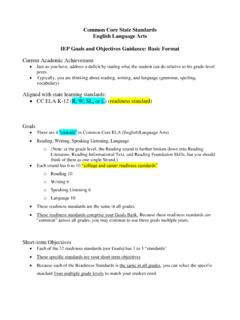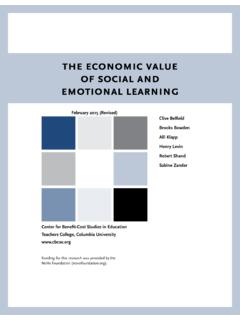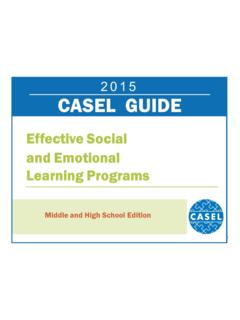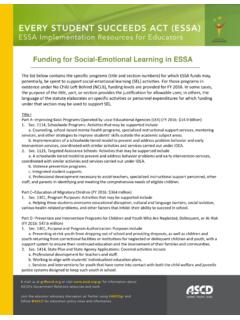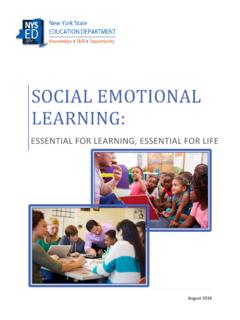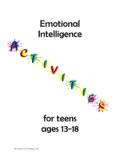Transcription of A.E.R.O. Social Emotional Learning Curriculum s
1 Social Emotional Learning Curriculum 9/2012 Curriculum Department. 1 L e a r n i n g W i t h o u t B o u n d a r i e s Social Emotional Learning Curriculum Administrators & Staff Members 7600 South Mason Avenue Burbank, IL 60459 (708)496-3330 Social Emotional Learning Curriculum 9/2012 Curriculum Department. 2 Social Emotional Learning Curriculum 9/2012 Curriculum Department. 3 Special Education Cooperative Social Emotional Learning (SEL) Curriculum Introduction The Illinois State Board of Education (ISBE) organized the SEL Standards to acknowledge that there are overlaps in instruction for SEL concepts and skills from one grade level to the next. For (a) ease of implementation, (b) prioritization of the SEL Standards using the Power Standards approach, and (c) to identify necessary resources for the instruction of SEL skills, AERO has carefully re-structured the ISBE SEL Standards in our Curriculum design.
2 The Standards were delineated to prioritize the key concepts in each specific grade level for all learners, and is not to be interpreted for use solely for learners receiving Social work services. The chart below identifies specifically how the SEL Performance Indicators were organized for the purposes of (a) instruction, (b) to more easily identify mid-year grade level expectations for non-disabled peers, and (c) to provide adaptations and interventions. SEL Stage A=All 1st grade to early 2nd grade AERO SEL 1st Grade=Stage A SEL Stage B=Late 1stgrade, all 2nd grade, early 3rd grade AERO SEL 2nd Grade= Stage B SEL Stage C= late 2nd grade, all third grade, early 4th grade AERO SEL 3rd Grade=Stage C SEL Stage D= late 3rd grade, all 4th grade, early 5th grade AERO SEL 4th grade=Stage D SEL Stage E= late 4th grade, all 5th grade, early 6th grade AERO SEL 5th grade=Stage E SEL Stage F=late 5th grade, all 6th grade, early 7th grade AERO SEL 6th grade= F SEL Stage F=late 6th grade, all 7th grade, early 8th grade AERO SEL 7th grade= Stage G SEL Stage G= late 7th grade, all 8th grade, early 9th grade AERO SEL 8th grade= Stage H SEL Stage H=late 8th grade, all 9th grade.
3 All 10th grade AERO SEL 9th and 10th grade=Stage I SEL Stage I= late 10th grade, all 11th grade, early 12th grade AERO SEL 11th grade=Stage I SEL Stage J=late 11th grade, all 12th grade AERO SEL 12th grade and 12+=Stage J Leadership In Social Emotional Learning Including using SEL problem-solving and critical-thinking activities in [typical] academic curricula ( , literacy, history, and performing arts); using collaborative strategies to involve students in improving school and classroom climates; altering instructional processes to foster more cooperative Learning and project-based Learning ; and reflecting SEL in behavior management and discipline practices and policies by including positive behavior and contributions [are critical]. (Transformative Leadership for Social - Emotional Learning Maurice J.)
4 Elias, Mary Utne O Brien, and Roger P. Weissberg, 2006 p. 12) Social Emotional Learning Emotional Literacy is the ability to identify, understand, and express emotions in healthy ways. ( ) Social Emotional Learning Curriculum 9/2012 Curriculum Department. 4 Illinois SEL Goals Best practices must include classroom level instruction to allow children the opportunity to explore, practice, and develop these core Social and Emotional skills: 1. Develop self-awareness & self-management skills to achieve school & life success. Self-Awareness: accurately assessing one s feelings, interests, values and strengths/abilities, and maintain a well-grounded sense of self-confidence Self-Management: regulating one s emotions to handle stress, control impulses, and persevere in overcoming obstacles: setting personal and academic goals and then monitoring one s progress toward achieving them; and expressing emotions constructively.
5 2. Use Social -awareness & interpersonal skills to establish & maintain positive relationships. Social -Awareness: taking the perspective of and empathizing with others; recognizing and appreciating individual and group similarities and differences; identifying and following societal standards of conduct; and recognizing and using family, school and community resources. Relationship Skills: establishing and maintain healthy and rewarding relationships based on cooperation; resisting inappropriate Social pressure; preventing, managing and resolving interpersonal conflict; seeking help when needed. 3. Demonstrate decision-making skills & responsible behaviors in personal, school, and community contexts. Responsible Decision-Making: making decisions based on consideration of ethical standards, safety concerns, appropriate standards of conduct, respect for others, and likely consequences of various actions, applying decision-making skills to academic and Social situations; and contributing to the well-being of one s school community.
6 Social Emotional Learning Curriculum 9/2012 Curriculum Department. 5 AERO Social Emotional Learning BIG IDEAS , ESSENTIAL QUESTIONS, & PRIORITY SKILLS: Self Awareness (SEL 1A, 1B, 1C, and 3C) ..13 What feelings do people experience and the reasons why? What are my personal traits and the supports I need? What are my goals and why is it important to set, plan, and accomplish goals? In what ways can I be involved and what are the benefits? AERO Priority Skills Emotions Wants/Needs Preferences Strengths and Challenges Delayed Gratification (Self-Management) Initiative Independent/Domestic Life Skills Self Management/ Social Awareness/Relationship Skills (SEL 2A, 2B, 2C, 2D)..33 In what ways are we the same and different and how do our differences enhance or expand our understandings and relationships?
7 How do others feelings and thoughts affect me? In what ways can I positively contribute to others feelings? How does what I say and do help or harm my relationships with others? What do my actions say about me to others? How does resolving and managing conflict benefit me and society? AERO Priority Skills Interpersonal Skills (relationship skills) Similarities and Differences Attending ( Social awareness) Social Interaction-Play Social Interaction-Communication Social Interaction-Friendship Anger Management Problem Solving Consequences Responsible Decision-Making (SEL 3A, 3B)..57 How does giving respect for others and the environment help me gain respect from others in various environments? In what ways can we show pride and advocate responsibly? AERO Priority Skills Respect Environmental Settings- such as Home, School, Community, and Work Place Advocacy Responsible Judgment and Choices Social Emotional Learning Curriculum 9/2012 Curriculum Department.
8 6 Social Emotional Learning Curriculum Key Concepts Elementary SEL: Grades 1st-12th Prioritized Key Concepts from SEL Performance Descriptors 1st Grade 2nd Grade 3rd Grade 4th Grade 5th Grade 6th Grade SEL 1A Identify emotions Identify emotions in self and others Understanding that feelings change. Identify things that trigger specific emotions. Identify positive supports to deal with conflict. Describe how one s body feels to a range of emotions. Identify situations that evoke positive and negative stress. Share Identifying places/ situations that evoke certain emotions. Identify intensity of emotion. Use I statements. Evaluate ways of dealing with upsetting behavior. Reflect on possible consequences. Identify ways to stay calm Demonstrate emotions through facial expressions and body language.
9 Practice calming techniques. Demonstrate awareness of how behaviors affect others. Practice handling situations where the student is under pressure. Practice an understanding of emotions through role playing. - Practice self talk - Practice multiple calming techniques. - - SEL 1B Describe things you do well and that make you feel good Identify resources and helpers in your community. Identify community members that can provide support. Describe ways you can help out in various environments. Identify a time when you needed help, who you could seek help from, and how that influenced you. Name community resources Identify the values and people who help you make good choices Identify personal traits of characters in a story. Describe positive qualities of successful people. Identify things you would like to do better and different support systems within your environment.
10 Describe leadership roles within your school that you can be a part of. Identify person strengths and weaknesses. Differentiate confident/need help Identify achievements that make you feel proud. Identify challenging things within your environment. List family and peer supports. Strategies to support peers. Analyze the efforts of your support system and what it means to care for others Identify who can help you. Identify a way to have done better. Describe the benefits of practicing. Measure progress. - - SEL 1C Learn how to set goals, what you need to change about yourself to achieve the goal, and the relationship between getting a goal and achieving it. Understanding the relationship between successes at achieving your goal. Identifying situations that need to be changed and how your can change your behavior to achieve success.
